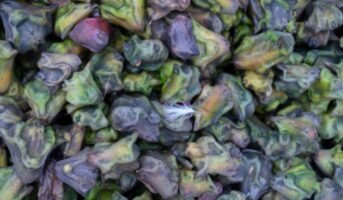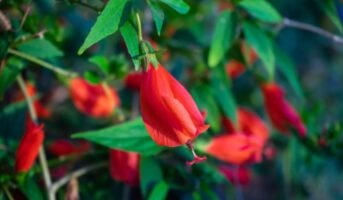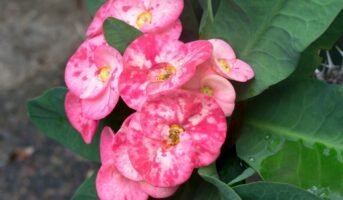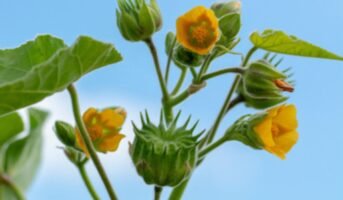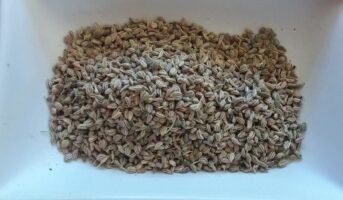As a result of its widespread distribution in India, the deciduous plant Cordia dichotoma, or Indian cherry, has long been used in traditional Indian medicine. A high concentration of polysaccharides has been detected in the fruit.
In India, C. dichotoma is the main element in the polyherbal formulation known as joshandah, which is widely used by the masses to cure a common cold, catarrh, cough, respiratory distress, and fevers.
Leaves and stem bark have been used to cure digestive issues, fever, diarrhoea, leprosy, gonorrhoea, and a burning feeling since ancient times. Plant leaf historically demonstrates medicinal applications and activities, including anthelmintic, astringent, and diuretic.

Source: Pinterest
See also: Tips to grow and take care of anthurium
Cordia dichotoma: Key facts
| Common name | Indian cherry |
| Botanical name | Cordia dichotoma |
| Family | Boraginaceae |
| Maximum height | 27 m |
| Native Habitat | Terrestrial |
| Sun exposure | Full Sun |
| Soil pH | 6-6.5 |
see: all about Indian Vegetables
Cordia dichotoma: Features
- C. dichotoma is a widespread species that may be found in tropical and subtropical areas.
- Up to about 1,500 metres in height, it may be found growing in the sub-Himalayan tract as well as the outer mountains.
- It may be found in many different types of woods, ranging from the dry deciduous forests of Rajasthan to the wet deciduous forests of the Western Ghats in India and even the tidal forests in Myanmar.
- It is native to the monsoon forests of Maharashtra, which are wet and humid.
- Its distribution is rather broad. In addition, it spread over other regions, such as Peninsular Malaysia, tropical Australia, and Polynesia.
- The method through which the species is perpetuated is through seeds.
Cordia dichotoma: Growing tips
- Regions with a mean annual rainfall of between 250 and 3,000 millilitres are ideal for the growth of this plant.
- In regions with an annual rainfall of fewer than 500 millimetres, it is more likely to be found beside streams or depressions that have access to moisture.
- It grows well in a variety of soils, but its ideal environment is one that is rich, wet, and sandy.
Growing by propagation:
- Direct sowing of seed into pots, beds, or trays is recommended.
- Around three to four weeks pass before the germination process may be considered complete.
- The process of germination can be sped up by first scarifying the seed, which involves lightly abrading the seed coat in order to make it easier for water to enter the seed.
- As soon as the seedlings have produced their first pair of genuine leaves, they should be transplanted into individual pots.
- At lower elevations, seedlings that are large enough to plant out can be acquired after three to four months in the nursery; however, at higher altitudes, the time required is nine to twelve months.
- Epigeous germination occurs, which means that one or two seedlings may emerge from a single stone. When stored in an airtight container, seeds have a storage life of at least one year.
- The process of growing plants from woody stems has been carried out well. The stumps should have a thickness of 8 to 13 mm at the root collar, with a stem length of around 4 centimetres and a root length of 20 to 25 centimetres.
- Before being stumped, these kinds of plants need to be grown in beds for a period of 12 to 15 months.
- The seedlings should be exposed to full light except for the first week after they have been pricked out, at which time they should be shaded.
see also about: cherry tree
Cordia dichotoma: Maintenance tips
- Young seedlings are susceptible to damage from cold and can struggle when left in the hot heat.
- They are vulnerable to being browsed on and to being burned by fire, although they heal rather well from both injuries.
- The tree may be successfully pollarded and coppiced.
- When grown in optimal conditions, the trees may attain a height of four metres in just four years and a diameter of more than twenty centimetres in just eight or nine years.
- When it is in the pole stage, it likes to have a total overhead light, but when it is in the seedling or sapling stage, it can tolerate a reasonable bit of shadow.

Source: Pinterest
Cordia dichotoma: Uses
- The leaves are used as plates and cigar wraps.
- The extract of the leaves is commonly found as a component in several commercially available cosmetic products.
- The seeds may be crushed up to extract oil.
- Mucilaginous fruit may be used to make glue if the right conditions are met.
- The wood is hard, moderately robust, and ages well, but insects quickly begin feeding on it when it is cut down. It is utilised in the building of homes as well as in the production of agricultural tools.
- The wood from the tree is used for heating and cooking.
Edible Uses:
- The entire C. dichotoma plant can be consumed as food since the entire plant is edible. Pickles are made from immature fruits, which are also consumed raw or cooked like vegetables.
- Raw fruits are a staple diet for Orissa’s rural population, particularly in coastal areas. It’s possible that cattle might be fed the seed kernels of the C. dichotoma plant since they contain a significant amount of both fatty oils and proteins.
- Polysaccharide gum is produced from the plant at a concentration of 97% and utilised for a variety of medicinal applications.
- Chromium, which is contained in the fruit, has been shown to have a therapeutic effect in the treatment of diabetes.
Medicinal Uses:
- Cordia dichotoma’s therapeutic history dates back to ancient Egypt. Bark, leaves, and fruit all contain mucilage and are diuretic and demulcent. They relieve stomach aches, coughs, and chest ailments.
- Researchers have extracted active chemicals from the plant. Alpha-amyrin and 5-dirhamnoside have anti-inflammatory properties.
- Its demulcent and mucilaginous qualities help cure coughs, sore throats, chest complaints, and urinary tract irritations. In big dosages, it’s a laxative for bilious problems.
- Fresh fruit is used to treat skin outbreaks and gonorrhoea.
- A decoction of the stem bark is used to cure dyspepsia, diarrhoea, dysentery, fever, headache, and stomachache. After childbirth, it’s useful.
- The bark strengthens teeth.
- The leaf juice is used to alleviate migraines, inflammation, and swelling.

Source: Pinterest
FAQs
How do you utilise Cordia dichotoma?
It is a versatile plant that has different uses, like medicinal and also used as a fruit as well as a vegetable.
Cordia dichotoma is also known as?
It’s also known as Indian cherry.
Is Cordia dichotoma poisonous?
No, the plant doesn’t have any known toxic effects.
Housing News Desk is the news desk of leading online real estate portal, Housing.com. Housing News Desk focuses on a variety of topics such as real estate laws, taxes, current news, property trends, home loans, rentals, décor, green homes, home improvement, etc. The main objective of the news desk, is to cover the real estate sector from the perspective of providing information that is useful to the end-user.
Facebook: https://www.facebook.com/housing.com/
Twitter: https://twitter.com/Housing
Email: [email protected]

